The Egyptian gods of Kommos

Posted for James Stratis.
During the fourth season of the Kommos excavation in 1979 the team from the University of Toronto, discovered, amongst other finds, two faience statues of Egyptian deities – Sekhmet (AB85) and Nefertum (AB86). The fact that both statues were found together points to a connection with Memphis, Egypt. This is where Sekhmet was the consort of Ptah and the mother of Nefertum.
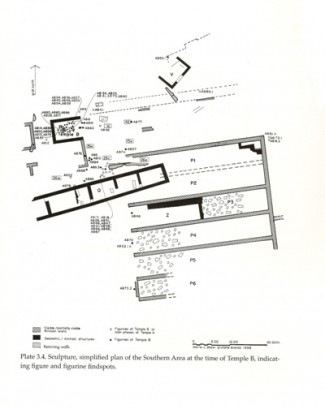
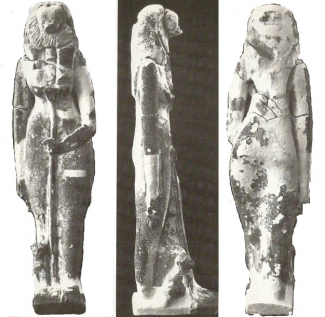
According to the Excavation Director Joseph Shaw: “(The statue of Sekhmet) was found between the central and southern pier of the sanctuary of the three pillars “on a bronze figurine of a horse with her head facing the East. It is no coincidence that a figurine of Nefertem … (was) found between the central and north pier. The two figurines of faience and a bronze horse had been placed (there) deliberately, probably in a position where they were found during a late phase of Temple B “
The Sekhmet statue portrays her as a standing lion-headed goddess, holding a lotus scepter, with a small cat beside her feet. The cat probably represents the goddess Bastet with whom Sekhmet was sometimes associated. Sekhmet was an ancient major deity. The lioness Sekhmet was both feared and revered by the Egyptians as the Eye of Re, the sun god. One myth says she killed almost all humanity at Re’s command. When Re thought humans were plotting against him, he sent Sekhmet to punish them. Sekhmet was stopped only when she was tricked into drinking large quantities of beer and she passed out. As time went on, she assumed other protective aspects becoming both “the lady of terror” and “the lady of life”. Her priests specialized in performing medicine and magic to avert all manner of plagues, illnesses, and mishaps that were attributed to her displeasure. Her worship began in the early Old Kingdom times and continued over thousands of years through the Greco-Roman period. Hundreds of statues of Sekhmet were set up at Karnak at the temple of Mut, another major lioness-goddess.
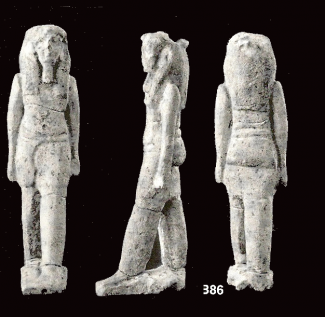
The second statue found at Kommos was of a standing, striding Nefertem. The Nefertem typically occurs in human form with his symbol, a blue lotus flower on his head. That emblem seems to be broken off, the Kommos statue. Sometimes he is depicted emerging from a lotus flower. The lotus symbol harkens back to his association with perfume. “Nefertem was thus associated not only with the blue lotus (Nymphaea cerulea) but also with the sun god who emerged from it” (Wilkinson, 2003) According to Sir J.D. Wilkinson, Nefertum was associated with royalty but was feared by the common people as the son of Sekhmet. Amulets to protect against Nefertum as well as amulets of Nefertum are traced from the Third Intermediate Period, the time when the Kommos statues were made.
Finally, it should be noted that the statues of Sekhmet and Nefertem have been discovered in other places in Crete: a Nefertem statue was found at Knossos, a Sekhmet at Eleftherna. Pendants of both gods were discovered in the sanctuary of Zeus Thenatas Amnisos, as were amulets and statuettes in the Inatos cave.
Why these two particular Egyptian figurines were brought to Kommos is unknowable but several general observations can be made. Egypt was ruled by foreign Dynasties during the time period of Temple B at Kommos. Lybian Pharaohs were in charge from roughly 940 to about 720 BCE. Some of them were from Bubastos, the city of cat goddess Bastet; others from Leontopolis.
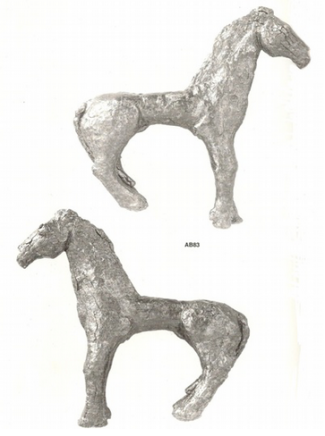
discovered below the Egyptian god statuettes
According to Wikipedia,” The Greek name of this city means, “City of Lions”, given on account of the presence of temples to the lioness goddesses Bast and Sekhmet and with their son, Maahes the lion prince.” The personality traits of later period Egyptian gods tend to be blended together, as when they share similar general characteristics.
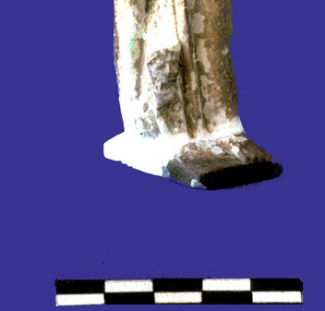
After the Lybian Dynasties came the Nubian pharaohs and the Saite Dynasty. Trade increased under the Saites. Earlier, native Egyptian dynasties tended to be xenophobic, but these later ones of foreign origin were more open to the rest of the Mediterranean world. For example: the Saite pharaoh Psamtik or Psammitichus threw off Assyrian control with the help of Greek and Carian mercenaries around 653 BCE. Whether Cretans were involved is unknown. In gratitude, Psamtik allowed the mercenaries to remain permanently in Egypt and gave them large tracts of land in the Nile Delta.
As a side note, the Carians were from southwestern Anatolia and were not Greek. After 2000 BCE they apparently migrated to Anatolia from somewhere else. The earliest archeology of Caria seems to be Minoan.
This article/ blog is indebted first and foremost to the research and writings of professors Maria and Joseph Shaw. Vassilis Chrysikopoulos has contributed the Greek language version of interpretation from the writings cited below of the Shaw’s publications on the Egyptian statuettes. Robert Bigelow reorganized, simplified and rewrote James Stratis’ original mashup. Holly Joyce and Jackie Stratis provided editing.
Additional reading:
·Hesperia Excavations at Kommos (Crete) During 1979 by J.W. Shaw
·Kommos Volume IV Chapter 3 by M.C. Shaw
·Various publications by V. Chrysikopoulos
·Petitions to the Divine : Communication Through Votive Offerings at Egyptian Shrines by G. Heffernan
·Ελλάδα – Αίγυπτος μία σχέση αιώνων Greece-Egypt Chelmpl
·Greece & Egypt Facebook
You can follow us on Twitter (@KommosAP) or join us on Facebook (Kommos Conservancy).
“Μπορείτε να μας ακολουθήσετε στο Twitter (@KommosAP) ή στο Facebook (Kommos Conservancy).”

Herodotus, who was himself part Carian, says (Book 1 454 1.171):
“[2] The Carians came to the mainland from the Cyclades islands. Long ago they had occupied the islands as subjects of Minos and were called the Leleges. As far back as I have been able to trace them by hearsay, they paid no tribute to Minos but did provide the manpower for his ships whenever he needed them. [3] Inasmuch as Minos conquered a great deal of territory and was successful in war, the Carians became by far the most famous of all peoples at that time. [4] The Hellenes, in fact, adopted three of their inventions for their own use. The Carians taught them how to tie plumes to helmets, to decorate shields with devices, and to attach handles to shields. Indeed, they were the first to use shield handles; until then anyone who bore a shield manipulated it not by handles, but rather by a leather strap worn around the neck and left shoulder. [5] Many years later, the Dorians and Ionians expelled the Carians from the islands, and so they came to the mainland. At least that is what the Cretans say happened, but the Carians themselves say they are indigenous to the mainland and have always had the name they do now. [6] As proof, they point to the ancient sanctuary of Carian Zeus in Mylasa, which the Mysians and Lydians share with them as kinsmen of the Carians, since Mysos and Lydos were brothers of Car. These, in fact, are the only ones who share the sanctuary; no one belonging to any other group is admitted to it, not even those who speak the same language as the Carians.”
Ref: Strassler, Robert B. ed. 2009. “The Landmark Herodotus: The Histories / Purvis, Andria L. Trans.” Anchor Books, NYC. p93.
More on Egyptian deities on Crete by the scholar Judith Weingarten
https://www.academia.edu/5799307/The_Arrival_of_Egyptian_Taweret_and_Bes_et_on_Minoan_Crete_Contact_and_Choice